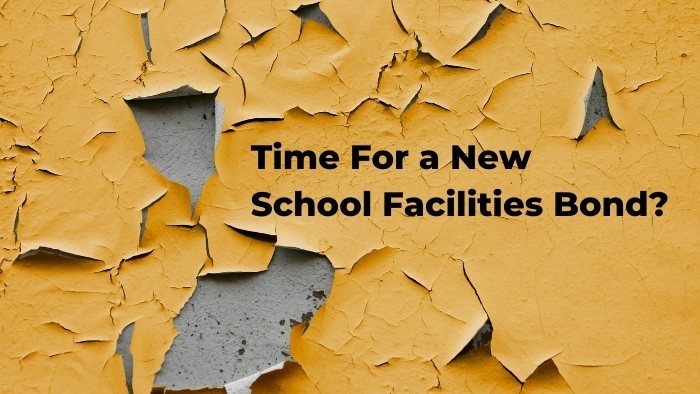Now can we fix California's school facilities?

California's ramshackle schools
School facilities can last a long time, but not forever. It has been a long time since the state of California invested significantly in them. In 2020, the state was on the cusp of acting on the problem, but bad luck intervened.
The state legislature had asked voters to approve the California School and College Facilities Bond. It would have provided billions for the purpose, but the timing was awful. The measure reached voters just as the dramatic quarantine of the Diamond Princess made America aware of a scary new threat with a strange name: COVID-19. Assigned the unlucky number 13, the measure failed.
In November 2024, California voters have another opportunity to do something about their rickety schools. After considering several competing options, the state legislature voted to put a bond measure on the state ballot for November 5, 2024. It will appear as Proposition 2 (2024).
This post takes a step back to explain how school facilities are paid for in California, along with some context for the current bond measure.
Grown fast, built fast
Compared to most states, California's population grew quickly. To keep up, school districts built fast and cheap. In many districts, prefabricated "portables" displaced open spaces and playgrounds.
With maintenance, schools can last a long time, but not all construction is of equal quality. Many of California's schools are sound, but some are in deep need of renovation. Some may have lingering problems with lead contamination, for example, and school heading and cooling systems are of uneven quality.
School districts tend to spend less than they should on ongoing maintenance. Instead, they defer maintenance costs — kind of like letting the "oil change" light shine and hoping for the best. When it can't wait anymore, they borrow money and pay it back over time. With interest, of course.
Borrowing it forward: School bonds
Periodically, schools need major renovation or outright replacement. School districts maintain their facilities through a combination of regular operating funds (the money that pays for everything from pencils to teacher salaries) and capital funds (the money for things that last years — usually raised by selling bonds).
Construction takes time and money. California communities don't generally pay for school construction out of pocket. Instead, they borrow money from investors in the bond market, committing to pay it back using future property tax revenue. The process is roughly similar to taking a home loan. The state sometimes provides some help in the form of statewide school bonds.
The role of state and local bonds for schools
Let's back up even further. First, a few big points to understand:
- Most school bonds are local. Most of the burden of school construction and maintenance is borne locally. Communities commit to pay additional local property taxes so their school district can sell school bonds for a specific project or set of projects. State law limits the amount of bond debt a school district may take on. This restriction is known as bonding capacity.
To pass a local school bond, a community vote of at least 55% is required. It wasn't always so. Prior to 1978, only a majority was required, but California voters passed Proposition 13, raising level to a 2/3 supermajority. Voters amended the state constitution again in 2000 by passing Prop 39, which lowered the supermajority hurdle to 55%.
- State bonds help. Historically, the state has supported school construction and modernization, too, by selling state school bonds repaid by state taxes. State bonds are put on the ballot by the legislature as a referendum. Passage requires majority approval. These state bonds have historically been structured as matching funds. That is, school districts qualify to receive bond funds from the state only if local voters pass a local property tax to issue their own local bonds.
- Fairness is an issue. Opposition to state school bonds can be motivated by general anti-tax sentiment or by concerns about fairness. State bond funds have historically benefited school construction in more-wealthy districts far more than they have in less-wealthy districts. CalMatters published a detailed analysis of this issue in 2020. In 2024 Public Advocates, a non-profit law firm and advocacy organization, warned that the school bond measures then under consideration might be unconstitutional unless they did more to address fairness.
State school bonds in California are often structured to pay for facilities in both K-12 schools and community colleges. In this post, all figures relate only to bonds (or the portion of them) for pre-K-12 projects.
How often have voters supported state school bonds?
Out of twelve state bond measures for school construction and modernization that made it to the ballot in California since 1990, voters have passed ten. Adjusted for inflation to 2024 dollars, these bonds cumulatively delivered more than $100 billion in state funding for K-12 facilities.
What About Interest?
School facility bonds are loans. The size of a school bond (whether state or local) is usually expressed in terms of its principal — the amount of money that it will raise, hopefully soon. But the total long-term cost of a school bond also includes fees and interest.
During the decades examined above, average interest rates fell. Some school districts were able to take advantage of this trend, refinancing their bond debt to take advantage of lower rates. Interest rates spiked in recent years, which increased the cost of financing for school bonds. Higher rates mean less of the money goes toward building.
Who makes money from school facility bonds?
A school facility bond is a contract between the school district and its underwriters — the businesses, banks or investors that commit ahead of time to buy the bonds. A few dozen financial firms specialize in the business of underwriting bonds for school districts in California. In 2024 the biggest included Raymond James and Stifel.
How much do the bankers and investors make on these bonds? It depends. If your school district is growing, has adequate reserves and a good credit rating, it can borrow from underwriters more cheaply than if it has a history of fiscal mismanagement and declining enrollment. You can find details about your school district's credit rating and its current debts through the DebtWatch service on the site of the California State Treasurer.
Making school facilities more equitable
Public school facilities are mainly funded by local bond measures based on local property taxes, which reflect local wealth. Rich communities can afford to tax themselves to build and modernize nice local schools. Poorer communities, on the other hand, have a harder time putting together local money to build or renovate schools. In these school districts, shouldering the cost of school construction and renovation can be hard or even unthinkable.
One way to reduce the inequity in school facilities would be for state funds to play a bigger role. California's Local Control Funding Formula (LCFF) directs extra funding for the operation of schools toward schools where families are lower-income. The same has not been true of funds for school facilities.
In the past, state matching funds disproportionately benefited wealthier school districts, according to research undertaken for the Getting Down to Facts II project. Why? Among other reasons, wealthier school districts tend to have their act together. They can get financial documents completed quickly and correctly. In the past, this was a decisive advantage, because funds were reviewed and granted in the order received.
For the (failed) state school bond of 2020, many changes were planned. For example, state matching fund requests would no longer be processed in the order received. Instead, the priority order would be determined using a point system. For example, projects that involved lead abatement would receive special priority.
The 2020 state bond measure failed at the ballot box, but it succeeded in setting important precedents for the next attempt. For example, it called for districts with a low capacity to issue their own bonds to receive higher priority for state matching funds. It directed state matching funds based on the proportion of students that qualify as high-need under the definition used by the Local Control Funding Formula. To access matching funds, school districts would be required to make public a five-year plan explaining how the funds were to be used, along with "an inventory of existing facilities, sites, and property" and "the school district’s deferred maintenance plan." This would have been a new level of transparency.
Districts: Be ballot-ready. Start now.
The Pandemic thwarted state investment in school facilities in 2020, but the stars seem aligned for November 2024. State school bonds have a "while supplies last" quality to them. Savvy schol communities will have their plans ready ahead of time not only for the construction aspect of the work, but also for the public communication aspects. What construction and modernization work is needed in your district, and how will you build local support to tax for it?
This post was updated in August 2024.
Tags on this post
Bonds Equity Facilities Prop 13All Tags
A-G requirements Absences Accountability Accreditation Achievement gap Administrators After school Algebra API Arts Assessment At-risk students Attendance Beacon links Bilingual education Bonds Brain Brown Act Budgets Bullying Burbank Business Career Carol Dweck Categorical funds Catholic schools Certification CHAMP Change Character Education Chart Charter schools Civics Class size CMOs Collective bargaining College Common core Community schools Contest Continuous Improvement Cost of education Counselors Creativity Crossword CSBA CTA Dashboard Data Dialogue District boundaries Districts Diversity Drawing DREAM Act Dyslexia EACH Early childhood Economic growth EdPrezi EdSource EdTech Education foundations Effort Election English learners Equity ESSA Ethnic studies Ethnic studies Evaluation rubric Expanded Learning Facilities Fake News Federal Federal policy Funding Gifted Graduation rates Grit Health Help Wanted History Home schools Homeless students Homework Hours of opportunity Humanities Independence Day Indignation Infrastructure Initiatives International Jargon Khan Academy Kindergarten LCAP LCFF Leaderboard Leadership Learning Litigation Lobbyists Local control Local funding Local governance Lottery Magnet schools Map Math Media Mental Health Mindfulness Mindset Myth Myths NAEP National comparisons NCLB Nutrition Pandemic Parcel taxes Parent Engagement Parent Leader Guide Parents peanut butter Pedagogy Pensions personalized Philanthropy PISA Planning Policy Politics population Poverty Preschool Prezi Private schools Prize Project-based learning Prop 13 Prop 98 Property taxes PTA Purpose of education puzzle Quality Race Rating Schools Reading Recruiting teachers Reform Religious education Religious schools Research Retaining teachers Rigor School board School choice School Climate School Closures Science Serrano vs Priest Sex Ed Site Map Sleep Social-emotional learning Song Special ed Spending SPSA Standards Strike STRS Student motivation Student voice Success Suicide Summer Superintendent Suspensions Talent Teacher pay Teacher shortage Teachers Technology Technology in education Template Test scores Tests Time in school Time on task Trump Undocumented Unions Universal education Vaccination Values Vaping Video Volunteering Volunteers Vote Vouchers Winners Year in ReviewSharing is caring!
Password Reset
Search all lesson and blog content here.
Login with Email
We will send your Login Link to your email
address. Click on the link and you will be
logged into Ed100. No more passwords to
remember!














Questions & Comments
To comment or reply, please sign in .
Jeff Camp - Founder July 1, 2024 at 1:46 pm
Peter McManus July 8, 2024 at 7:47 am
Jeff Camp - Founder July 8, 2024 at 10:06 pm
Peter McManus May 20, 2024 at 6:44 pm